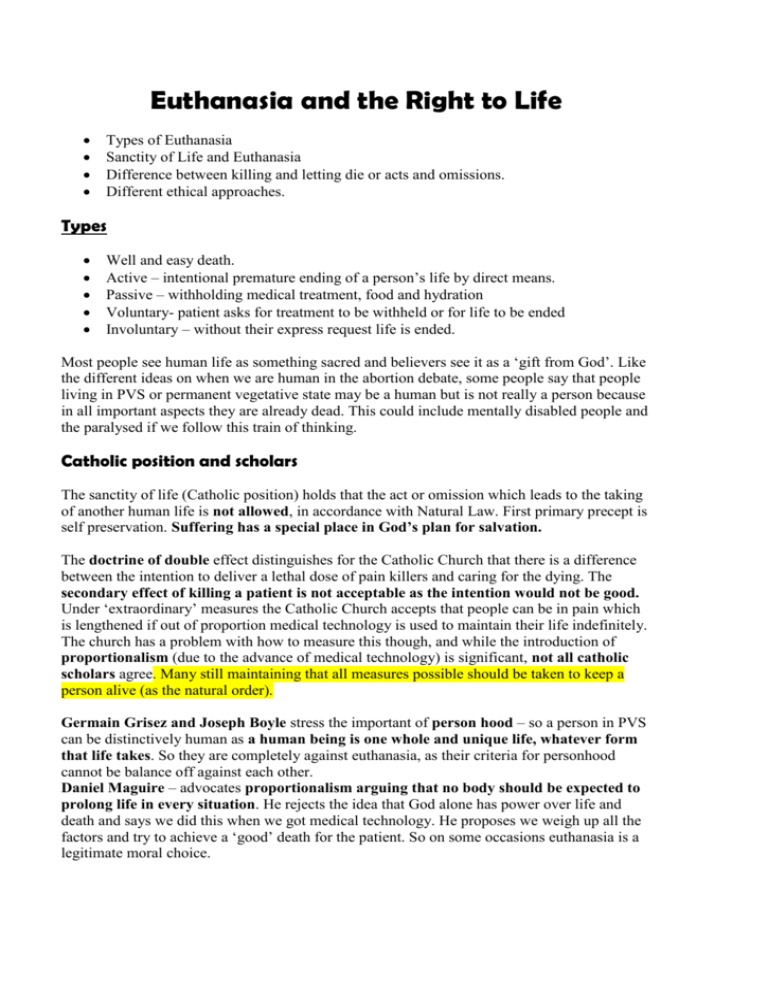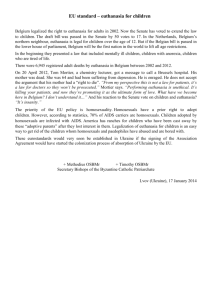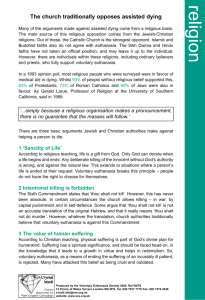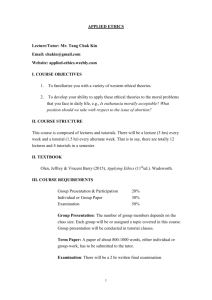Euthanasia and the Right to Life
advertisement

Euthanasia and the Right to Life Types of Euthanasia Sanctity of Life and Euthanasia Difference between killing and letting die or acts and omissions. Different ethical approaches. Types Well and easy death. Active – intentional premature ending of a person’s life by direct means. Passive – withholding medical treatment, food and hydration Voluntary- patient asks for treatment to be withheld or for life to be ended Involuntary – without their express request life is ended. Most people see human life as something sacred and believers see it as a ‘gift from God’. Like the different ideas on when we are human in the abortion debate, some people say that people living in PVS or permanent vegetative state may be a human but is not really a person because in all important aspects they are already dead. This could include mentally disabled people and the paralysed if we follow this train of thinking. Catholic position and scholars The sanctity of life (Catholic position) holds that the act or omission which leads to the taking of another human life is not allowed, in accordance with Natural Law. First primary precept is self preservation. Suffering has a special place in God’s plan for salvation. The doctrine of double effect distinguishes for the Catholic Church that there is a difference between the intention to deliver a lethal dose of pain killers and caring for the dying. The secondary effect of killing a patient is not acceptable as the intention would not be good. Under ‘extraordinary’ measures the Catholic Church accepts that people can be in pain which is lengthened if out of proportion medical technology is used to maintain their life indefinitely. The church has a problem with how to measure this though, and while the introduction of proportionalism (due to the advance of medical technology) is significant, not all catholic scholars agree. Many still maintaining that all measures possible should be taken to keep a person alive (as the natural order). Germain Grisez and Joseph Boyle stress the important of person hood – so a person in PVS can be distinctively human as a human being is one whole and unique life, whatever form that life takes. So they are completely against euthanasia, as their criteria for personhood cannot be balance off against each other. Daniel Maguire – advocates proportionalism arguing that no body should be expected to prolong life in every situation. He rejects the idea that God alone has power over life and death and says we did this when we got medical technology. He proposes we weigh up all the factors and try to achieve a ‘good’ death for the patient. So on some occasions euthanasia is a legitimate moral choice. So Maguire believes that sanctity of life can still be intact if the dying process shows that life has reached its limit. Then euthanasia is allowed for a good death. (refusing medical treatment). Peter Singer (preference utilitarian) believes that the sanctity of life ethic must collapse and we need to develop a new ethic because people now believe that the quality of life has precedence over what ever origins life may have. However Singer fails to consider the effect on others around the dying patient. QUALYS (Quality adjusted life year schedules). This idea is basically utilitarian, and measures whether the use of extraordinary means would usefully improve the quality of life of the dying patient. Interestingly, under the catholic position the decision is in the hands of the patient, who can refuse treatment if they have accepted that they are dying, and wish to do so naturally because any medical procedure would just prolong their life, or if the procedure would pose an unnecessary expense on their family. No one is obliged to have a medical procedure which is risky or burdensome. Euthanasia and the right to life Right to life means others have a duty not to kill you, which would appear to immediately conflict with all forms of euthanasia. We (society) however have not applied the duty not to kill absolutely (wars, capital punishment, self defence) so there is room to allow a rational person to make a decision about whether they wish to die. Isn’t there? If this is allowed who then has the duty to kill the patient? Doctors may be happy to withdraw treatment or assist suicide (pills etc) but not happy about having a duty to kill at a patient’s request. (ie something more legal). Euthanasia and suicide Suicide is the deliberate termination by one’s own life. Many people are appalled at the idea of it, and religious believe it interferes with God’s plan, affects families and is not natural. Henry Sidgwick sees suicide as a statement by an intelligent being that life is meaningless. Should not be a criminal act as it was in the past. Aquinas saw suicide as unnatural and a rejection of God’s gift of an immortal soul. This was what was behind the criminal law. Today suicide is no longer illegal, but those who attempt it are evaluated by psychiatric professionals until it is determined that they are in their right state of mind. Ironically, a double standard seems to apply, suicide bombers etc are admired for their convictions, as are martyrs, soldiers, life threatening occupations – police fire and rescue. Additionally certain industries which cause ‘slow suicide’ eg alcohol, cigarettes and armaments are allowed. Euthanasia and personal automomy. John Stuart Mill (Rule utilitarian) – in individual matters people should have autonomy and these decisions should not be state controlled. Competency is the key. Issues arise with the information provided to the individual who is making the decision. Killing and letting die James Rachels – 1941-2003 argued that there was no difference between active and passive (letting die) euthanasia, and that in fact letting someone die was crueller as they would suffer more pain. When the result is the same ie the patient is dead, then surely active should be allowed. Many others argue that this process is a slippery slope and the value of human life will be depreciated and made subordinate to economics and social pressure, and personal convenience. Utilitarianism Basic principle – the greatest good for the greatest number What counts as a good consequence? Is it death, a good death? John Stuart Mill – good consequences create happiness, so freedom from pain that is physical and psychological is a good thing. We can apply his idea of victimless crime also, in the sense that if a patient has volunteered for euthanasia there is no crime and no victim. However, there are still the effects on society and doctor patient relationship issues to consider. Jeremy Bentham – Hedonistic measures of what constitutes the greatest pleasure sees Bentham agreeing with Mill that euthanasia is right because if a person’s existence brings more pain and suffering, both to them and to their family, then their life could be ended. The use of resources would approve of euthanasia as costly medicine could be applied elsewhere, and the preservation of dignity and the exercise of personal autonomy supports euthanasia. In a way, Utilitarianism supports it too much, there is no protection for the individual against the majority if all around decide death is the best choice, and there is no safeguarding of their rights. Natural Law Looks at the act of euthanasia itself, which is wrong under protection of life as a primary precept. NL does allow a patient to refuse treatment if it is over an above what is needed for existence – extraordinary means which enables each situation to be looked at individually. The weak sanctity of life argument says that where death is inevitable the doctor cares for the patient compassionately. ‘thou shalt not kill, but need not strive officiously to keep them alive’. AO1 Describe the main differences between the Utilitarianism of Bentham and Mill. AO2 Evaluate the claim that Utilitarianism is a useful method in judging issues of voluntary euthanasia.





